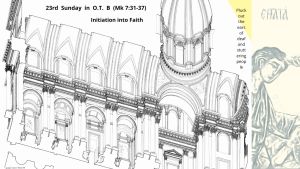
don Giuseppe Nespeca
Giuseppe Nespeca è architetto e sacerdote. Cultore della Sacra scrittura è autore della raccolta "Due Fuochi due Vie - Religione e Fede, Vangeli e Tao"; coautore del libro "Dialogo e Solstizio".
Jesus makes memory and remembers the whole history of the people, of his people. And he recalls the rejection of his people to the love of the Father (Pope Francis)
Gesù fa memoria e ricorda tutta la storia del popolo, del suo popolo. E ricorda il rifiuto del suo popolo all’amore del Padre (Papa Francesco)
Ecclesial life is made up of exclusive inclinations, and of tasks that may seem exceptional - or less relevant. What matters is not to be embittered by the titles of others, therefore not to play to the downside, nor to fear the more of the Love that risks (for afraid of making mistakes)
La vita ecclesiale è fatta di inclinazioni esclusive, e di incarichi che possono sembrare eccezionali - o meno rilevanti. Ciò che conta è non amareggiarsi dei titoli altrui, quindi non giocare al ribasso, né temere il di più dell’Amore che rischia (per paura di sbagliare).
Zacchaeus wishes to see Jesus, that is, understand if God is sensitive to his anxieties - but because of shame he hides (in the dense foliage). He wants to see, without being seen by those who judge him. Instead the Lord looks at him from below upwards; Not vice versa
Zaccheo desidera vedere Gesù, ossia capire se Dio è sensibile alle sue ansie - ma per vergogna si nasconde nel fitto fogliame. Vuole vedere, senza essere visto da chi lo giudica. Invece il Signore lo guarda dal basso in alto; non viceversa
The story of the healed blind man wants to help us look up, first planted on the ground due to a life of habit. Prodigy of the priesthood of Jesus
La vicenda del cieco risanato vuole aiutarci a sollevare lo sguardo, prima piantato a terra a causa di una vita abitudinaria. Prodigio del sacerdozio di Gesù.
Firstly, not to let oneself be fooled by false prophets nor to be paralyzed by fear. Secondly, to live this time of expectation as a time of witness and perseverance (Pope Francis)
Primo: non lasciarsi ingannare dai falsi messia e non lasciarsi paralizzare dalla paura. Secondo: vivere il tempo dell’attesa come tempo della testimonianza e della perseveranza (Papa Francesco)
O Signore, fa’ che la mia fede sia piena, senza riserve, e che essa penetri nel mio pensiero, nel mio modo di giudicare le cose divine e le cose umane (Papa Paolo VI)
O Lord, let my faith be full, without reservations, and let penetrate into my thought, in my way of judging divine things and human things (Pope Paul VI)
«Whoever tries to preserve his life will lose it; but he who loses will keep it alive» (Lk 17:33)
«Chi cercherà di conservare la sua vita, la perderà; ma chi perderà, la manterrà vivente» (Lc 17,33)
«And therefore, it is rightly stated that he [st Francis of Assisi] is symbolized in the figure of the angel who rises from the east and bears within him the seal of the living God» (FS 1022)
«E perciò, si afferma, a buon diritto, che egli [s. Francesco d’Assisi] viene simboleggiato nella figura dell’angelo che sale dall’oriente e porta in sé il sigillo del Dio vivo» (FF 1022)
This is where the challenge for your life lies! It is here that you can manifest your faith, your hope and your love! [John Paul II at the Tala Leprosarium, Manila]
È qui la sfida per la vostra vita! È qui che potete manifestare la vostra fede, la vostra speranza e il vostro amore! [Giovanni Paolo II al Lebbrosario di Tala, Manilla]
The more we do for others, the more we understand and can appropriate the words of Christ: “We are useless servants” (Lk 17:10). We recognize that we are not acting on the basis of any superiority or greater personal efficiency, but because the Lord has graciously enabled us to do so [Pope Benedict, Deus Caritas est n.35]
duevie.art
don Giuseppe Nespeca
Tel. 333-1329741
Disclaimer
Questo blog non rappresenta una testata giornalistica in quanto viene aggiornato senza alcuna periodicità. Non può pertanto considerarsi un prodotto editoriale ai sensi della legge N°62 del 07/03/2001.
Le immagini sono tratte da internet, ma se il loro uso violasse diritti d'autore, lo si comunichi all'autore del blog che provvederà alla loro pronta rimozione.
L'autore dichiara di non essere responsabile dei commenti lasciati nei post. Eventuali commenti dei lettori, lesivi dell'immagine o dell'onorabilità di persone terze, il cui contenuto fosse ritenuto non idoneo alla pubblicazione verranno insindacabilmente rimossi.










